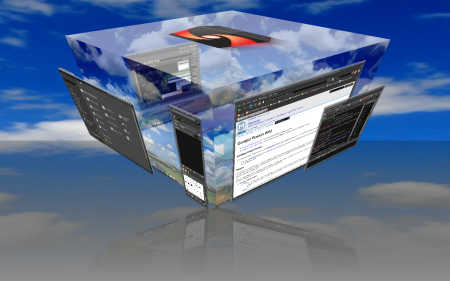
Compiz Fusion is the result of a merge between the well-known Beryl composite window manager and Compiz Extras, a community set of improvements to the Compiz composite window manager. Compiz Fusion aims to provide an easy and fun-to-use windowed environment, allowing use of the graphics hardware to render each individual window and the entire screen, to provide some impressive effects, speed and usefulness. The first Compiz Fusion developer release was Compiz Fusion 0.5.2 on August 13th 2007, shortly after Compiz 0.5.2 was released. First stable release of Compiz Fusion is 0.6.0 released on October 20 2007. (Snipped from the project home page)
It is, quite frankly, gorgeous! There are two stages in getting this beauty to work.
Manolis Kiagias has a nice page on how to set this up for FreeBSD here. That page goes into detail about how to set up Nvidia cards - mine is a Radeon and uses the ati driver. The Project homepage explains how to make it work - the resulting /etc/X11/xorg.conf file is here:-
Section "ServerLayout"
Identifier "X.org Configured"
Screen 0 "Screen0" 0 0
Option "AIGLX" "True"
InputDevice "Mouse0" "CorePointer"
InputDevice "Keyboard0" "CoreKeyboard"
EndSection
Section "Files"
RgbPath "/usr/local/share/X11/rgb"
ModulePath "/usr/local/lib/xorg/modules"
FontPath "/usr/local/lib/X11/fonts/misc/"
FontPath "/usr/local/lib/X11/fonts/TTF/"
FontPath "/usr/local/lib/X11/fonts/OTF"
FontPath "/usr/local/lib/X11/fonts/Type1/"
FontPath "/usr/local/lib/X11/fonts/100dpi/"
FontPath "/usr/local/lib/X11/fonts/75dpi/"
EndSection
Section "Extensions"
Option "Composite" "Enable"
EndSection
Section "Module"
Load "extmod"
Load "record"
Load "dbe"
Load "glx"
Load "GLcore"
Load "xtrap"
Load "dri"
Load "freetype"
Load "type1"
EndSection
Section "InputDevice"
Identifier "Keyboard0"
Driver "kbd"
Option "AutoRepeat" "500 30"
Option "XkbRules" "xfree86"
Option "XkbModel" "pc104"
Option "XkbLayout" "gb"
Option "XkbOptions" "ctrl:nocaps"
EndSection
Section "InputDevice"
Identifier "Mouse0"
Driver "mouse"
Option "Protocol" "auto"
Option "Device" "/dev/sysmouse"
Option "ZAxisMapping" "4 5 6 7"
EndSection
Section "Monitor"
340 270 # mm
Identifier "Monitor0"
VendorName "VSC"
ModelName "VP171b"
### Comment all HorizSync and VertRefresh values to use DDC:
HorizSync 30.0 - 82.0
VertRefresh 50.0 - 85.0
Option "DPMS"
EndSection
Section "Device"
### Available Driver options are:-
### Values: <i>: integer, <f>: float, <bool>: "True"/"False",
### <string>: "String", <freq>: "<f> Hz/kHz/MHz"
### [arg]: arg optional
Option "XAANoOffscreenPixmaps" "true"
Identifier "Card0"
Driver "ati"
VendorName "ATI Technologies Inc"
BoardName "Radeon R350 [Radeon 9800 Pro]"
BusID "PCI:1:0:0"
EndSection
Section "Screen"
Identifier "Screen0"
Device "Card0"
Monitor "Monitor0"
DefaultDepth 24
Option "AddARGBGLXVisuals" "True"
SubSection "Display"
Viewport 0 0
Depth 1
EndSubSection
SubSection "Display"
Viewport 0 0
Depth 4
EndSubSection
SubSection "Display"
Viewport 0 0
Depth 8
EndSubSection
SubSection "Display"
Viewport 0 0
Depth 15
EndSubSection
SubSection "Display"
Viewport 0 0
Depth 16
EndSubSection
SubSection "Display"
Viewport 0 0
Modes "1280x1024" "1024x768"
Depth 24
EndSubSection
EndSection
Then the script to start compiz and emerald the accompanying Window-Manager. This differs from Manolis' suggested script.
/bin/sh
LIBGL_ALWAYS_INDIRECT=true compiz —replace —indirect-rendering —sm-disable ccp &
emerald —replace &
Then use the GUI to add it to Startup Programs (located in System, Preferences, Sessions on a GNOME desktop).
Here's a sample